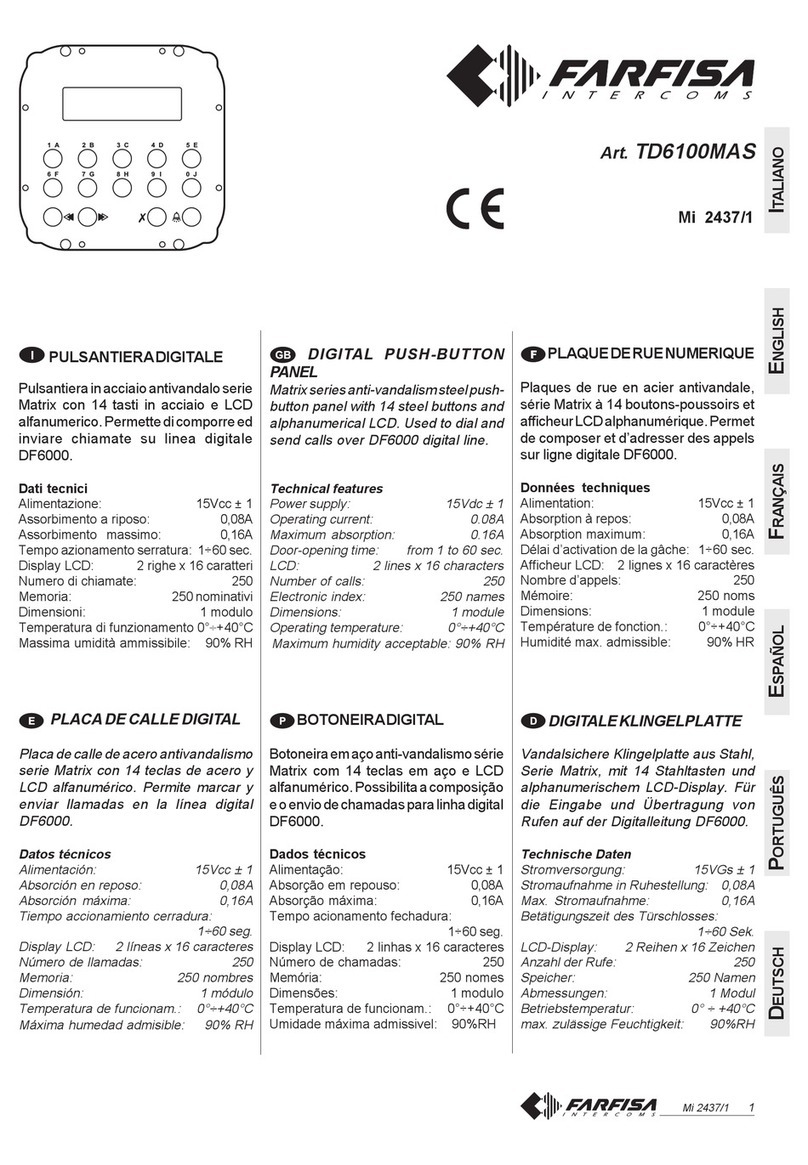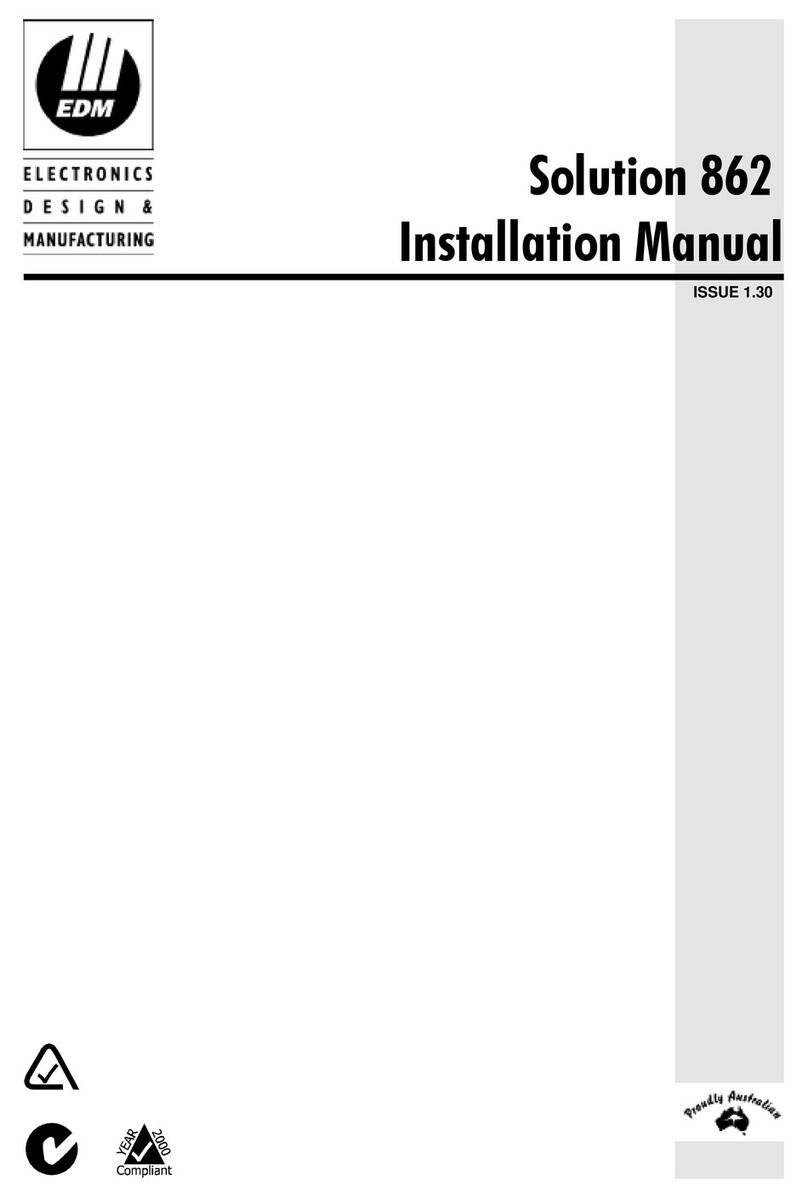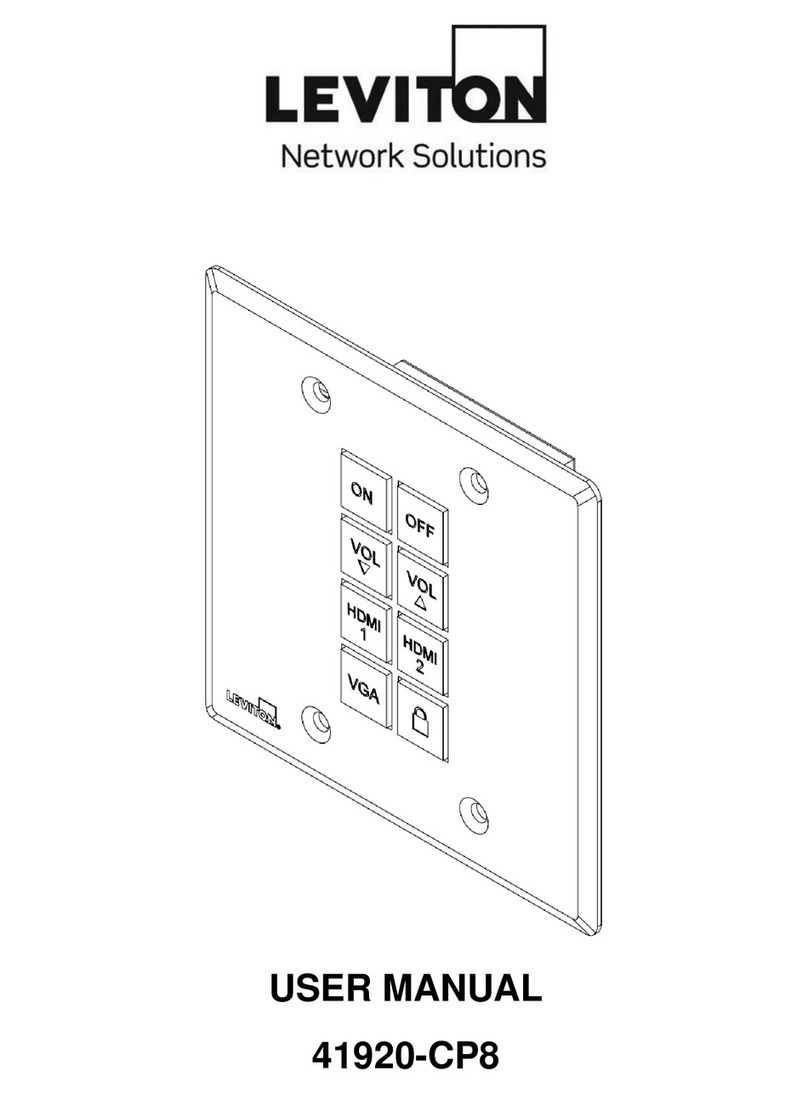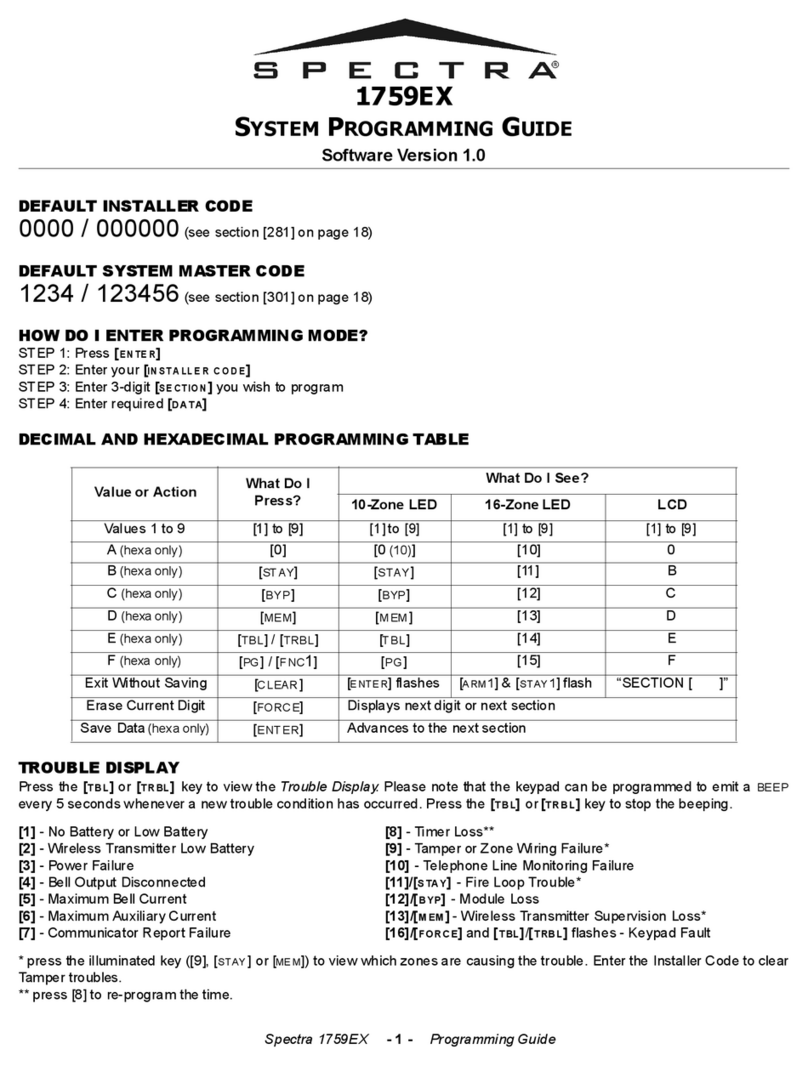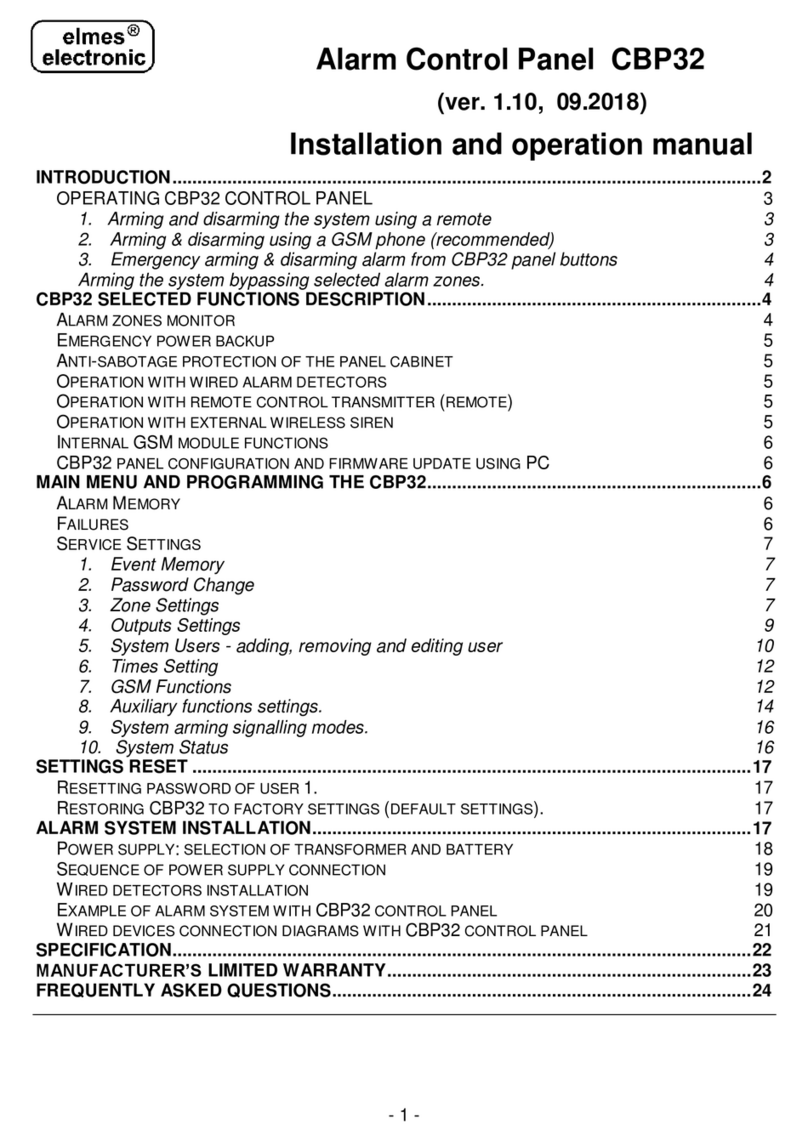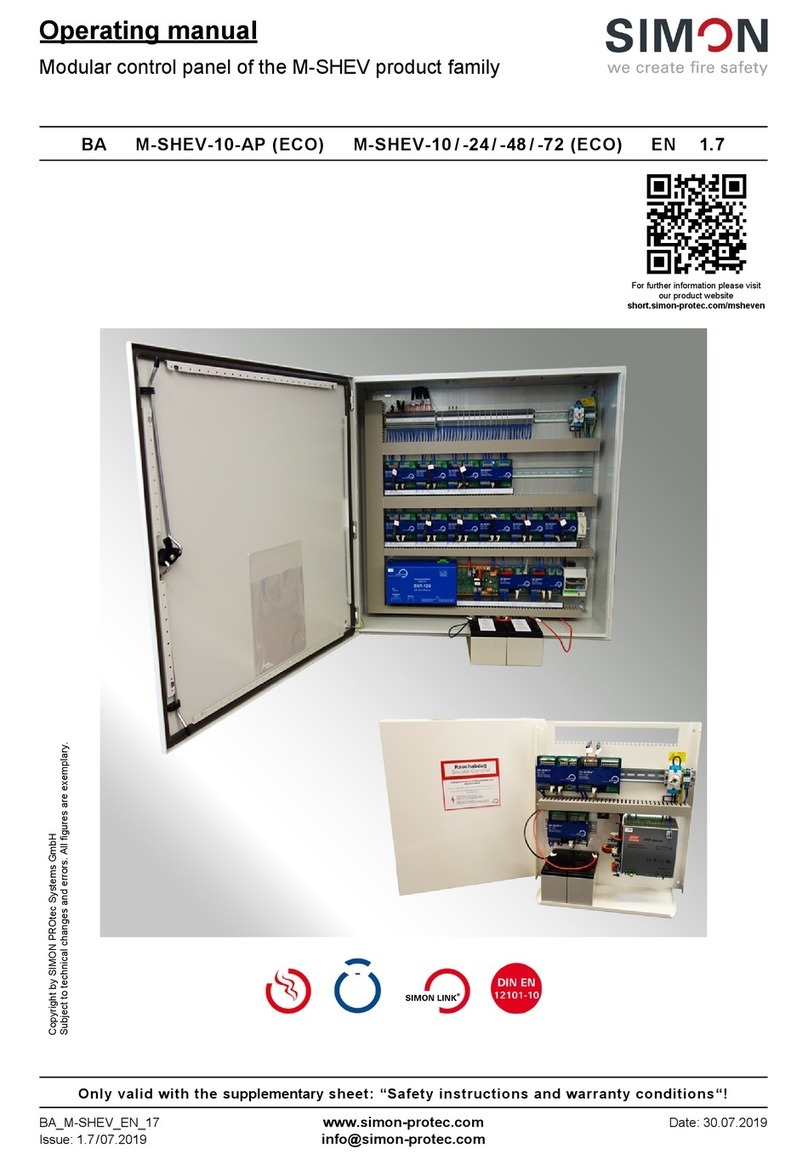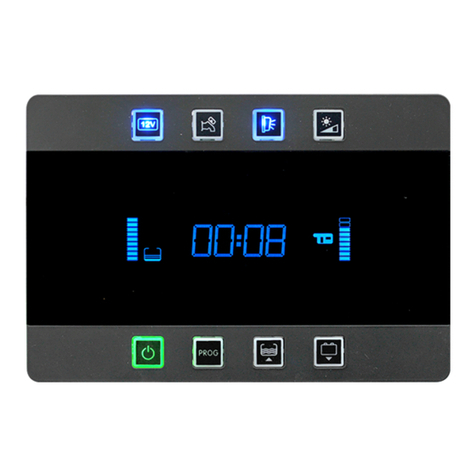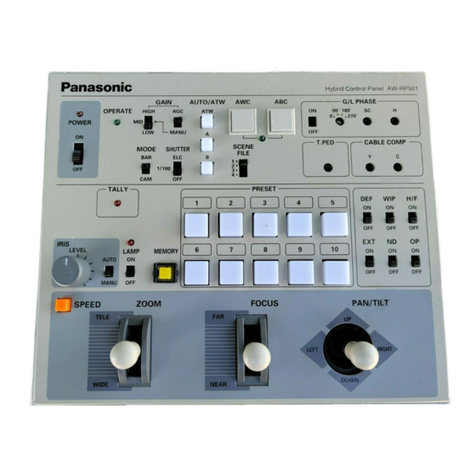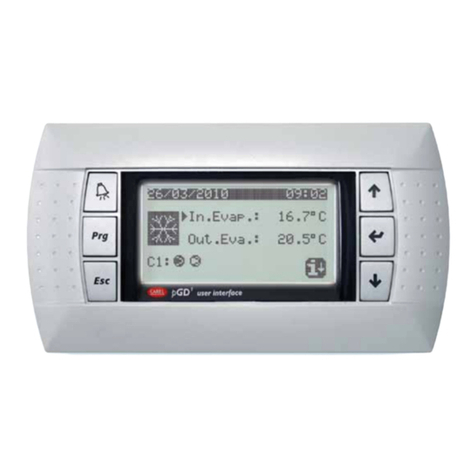Advanced Fire Systems AX Series User manual

AX
Series
INTELLIGENT FIRE ALARM CONTROL PANEL
INSTALLATION &OPERATION MANUAL

Page 2 of 80
Table of Contents
1Introduction / Overview.........................................................................................5
1.1Product Description.....................................................................................................................5
1.2System Components...................................................................................................................6
1.2.1Internal Peripherals................................................................................................................................6
1.2.2SLC Devices ..........................................................................................................................................6
1.2.3NAC Devices .........................................................................................................................................7
1.2.4Network Devices....................................................................................................................................7
1.3Limitations of Fire Alarm Systems..............................................................................................8
1.4General Installation Notes ..........................................................................................................8
2Agency Listings / Approvals / Requirements......................................................9
2.1ANSI/UL864................................................................................................................................9
2.2FCC.............................................................................................................................................9
2.2.1Emissions ..............................................................................................................................................9
3Installation............................................................................................................10
3.1Enclosure Dimensions..............................................................................................................10
3.2Circuit Card Installation.............................................................................................................11
3.2.1Replacing Base Card...........................................................................................................................12
3.2.2Adding function LED label or replacing Alphanumeric Graphical Display ............................................13
3.2.3Adding or replacing AX-LPD or AX-NAC module.................................................................................14
3.2.4Adding or replacing AX-NET4 or AX-NET7 module.............................................................................15
3.2.5Adding or replacing AX-CTY Module ...................................................................................................16
3.2.6Adding or replacing AX-PSU Module...................................................................................................16
3.2.6.1AX-PSU DC Wiring ....................................................................................................................................... 17
3.2.7Adding or replacing AX-RL8 Module....................................................................................................18
3.2.7.1Output Wiring ................................................................................................................................................ 18
3.3Circuit / Electrical Specifications...............................................................................................19
3.3.1AC Branch Circuit: ...............................................................................................................................20
3.3.2Battery Circuit: .....................................................................................................................................20
3.3.3Auxiliary DC Power Input.....................................................................................................................21
3.3.4AUX Supply Outputs............................................................................................................................21
3.3.5Relays..................................................................................................................................................21
3.3.6SLC Circuits.........................................................................................................................................22
3.3.6.1SLC Peripheral Devices ................................................................................................................................ 23
3.3.6.2AX Intelligent Smoke Detectors .................................................................................................................... 23
3.3.6.3AX Detector Base Wiring .............................................................................................................................. 27
3.3.6.4AX Intelligent Modules .................................................................................................................................. 29
3.3.6.5AX Intelligent Manual Pull Stations ............................................................................................................... 30
3.3.6.6AX Intelligent Addressable I/O Modules........................................................................................................ 30
3.3.6.6.1AX Series Monitors and Priority Monitors ............................................................................................. 31
3.3.6.6.2AX Series Output Modules................................................................................................................... 34
3.3.7NAC Circuits ........................................................................................................................................36
3.3.8Peripheral Bus Circuit ..........................................................................................................................37
3.3.9RS232 Circuit.......................................................................................................................................37
3.3.10USB Circuit ..........................................................................................................................................37
3.3.11Network Circuit ....................................................................................................................................37
3.3.12AX-RL8 Relay Module .........................................................................................................................39
3.3.13Interfacing to a Standalone Digital Alarm Communicator ....................................................................40
3.3.14Auxiliary - Reverse Polarity Signaling ..................................................................................................41
3.3.15Recommended Cable Routing.............................................................................................................42
3.4Loading Calculations.................................................................................................................43
3.4.1Panel Loading......................................................................................................................................43
3.4.2Battery Calculation for AX-CTL-2/2D ...................................................................................................43

Page 3 of 80
3.4.3Battery Calculation for AX-CTL-4/4D................................................................................................... 44
4Operation............................................................................................................. 45
4.1User Controls and Indications .................................................................................................. 45
4.1.1Control Keys ........................................................................................................................................ 45
4.1.2Navigation Keys................................................................................................................................... 46
4.1.3Number Keys....................................................................................................................................... 46
4.1.4LED Indications ................................................................................................................................... 46
4.1.5LCD Indications ................................................................................................................................... 47
4.2Fire Alarm Condition................................................................................................................. 47
4.2.1Unacknowledged and Acknowledged Alarms with and without Supervisory Events ........................... 47
4.2.2Alarm Condition - Silence, Resound and Reset................................................................................... 49
4.3Non-Alarm Conditions .............................................................................................................. 49
4.3.1Unacknowledged and Acknowledged Non-Alarm Events .................................................................... 49
4.4Obtaining Detailed Device Information During Events............................................................. 51
4.5Performing a Fire Drill............................................................................................................... 52
4.6Positive Alarm Sequence ......................................................................................................... 53
4.7Alarm Verification ..................................................................................................................... 55
4.8Multiple Detector Operation...................................................................................................... 55
4.9Disabled Condition ................................................................................................................... 56
4.10USER Menu Functions............................................................................................................. 57
4.10.1View Menu........................................................................................................................................... 58
4.10.1.1View Inputs.................................................................................................................................................... 58
4.10.1.2View Outputs ................................................................................................................................................. 59
4.10.1.3View Log........................................................................................................................................................ 59
4.10.1.3.1Event Log .............................................................................................................................................. 59
4.10.1.3.2Alarm Counter ....................................................................................................................................... 60
4.10.1.4View Panel .................................................................................................................................................... 60
4.10.1.5View - Network .............................................................................................................................................. 60
4.10.2Disable Menu....................................................................................................................................... 61
4.10.2.1Disable - Zones and Inputs ........................................................................................................................... 61
4.10.2.2Disable - Outputs........................................................................................................................................... 62
4.10.2.2.1All NAC Outputs .................................................................................................................................... 62
4.10.2.2.2All Other Outputs................................................................................................................................... 63
4.10.2.2.3Only Selected Outputs .......................................................................................................................... 63
4.10.2.3Disable - Controls.......................................................................................................................................... 64
4.10.2.4Disable – PAS (Positive Alarm Sequence).................................................................................................... 64
4.10.2.5Disable – User ID .......................................................................................................................................... 65
4.10.3Enable Menu ....................................................................................................................................... 66
4.10.3.1Enable - Zones and Inputs ............................................................................................................................ 66
4.10.3.2Enable - Outputs ........................................................................................................................................... 66
4.10.3.3Enable – PAS (Positive Alarm Sequence) .................................................................................................... 66
4.10.3.4Enable - Change-Time .................................................................................................................................. 66
4.10.4Test Menu............................................................................................................................................ 67
4.10.4.1Test - Zones .................................................................................................................................................. 67
4.10.4.2Test - Display ................................................................................................................................................ 69
4.10.4.3Test - Buzzer ................................................................................................................................................. 69
4.10.4.4Test - Printer.................................................................................................................................................. 69
4.10.5Print Menu ........................................................................................................................................... 69
4.10.5.1Printer Communications Settings .................................................................................................................. 69
4.10.5.2Set-up Printer ................................................................................................................................................ 70
4.10.5.3Print Inputs .................................................................................................................................................... 70
4.10.5.4Print Outputs ................................................................................................................................................. 71
4.10.5.5Print Troubles ................................................................................................................................................ 71
4.10.5.6Print Disables ................................................................................................................................................ 71
4.10.5.7Print - Log...................................................................................................................................................... 72
4.10.5.8Print - Feed Paper ......................................................................................................................................... 72

Page 4 of 80
5Maintenance & Troubleshooting ........................................................................73
5.1Troubleshooting........................................................................................................................73
5.1.1Base Card I/O Addresses and Built-in Intelligent Multi-Meter ..............................................................73
5.2Replacement of Components...................................................................................................75
5.2.1Batteries...............................................................................................................................................75
5.2.1.1Standby Batteries .......................................................................................................................................... 75
5.2.2Liquid Crystal Display ..........................................................................................................................75
5.3LED Status................................................................................................................................76
5.3.1Base Card............................................................................................................................................76
5.3.2AX-LPD Plug-In SLC/NAC Card ..........................................................................................................77
5.3.3AX-NET Plug-In Network Card ............................................................................................................77
6Appendices ..........................................................................................................78
6.1Device Additional Information...................................................................................................78
6.1.1View Drift .............................................................................................................................................78
6.1.2Intelligent Smoke Detector Drift Compensation: ..................................................................................78
6.1.3Rapid Compensation ...........................................................................................................................79
6.1.4View EEPROM ....................................................................................................................................80
6.1.5Loop Isolators ......................................................................................................................................80

Page 5 of 80
1 Introduction / Overview
1.1 Product Description
This manual covers the installation, programming and operation of the AX-CTL-2 and AX-CTL-4 Intelligent Fire Alarm
Control Panels.
The AX-CTL-2 is a Multiple Loop, Analog Addressable Intelligent Fire Alarm Control Panel with provision for up to two
signaling line circuits and two notification appliance circuits.
The AX-CTL-4 is a Multiple Loop, Analog Addressable Intelligent Fire Alarm Control Panel with provision for up to four
signaling line circuits and four notification appliance circuits.
An optional 5Amp power supply is available for additional system power.
All models are compatibility tested for use with the Advanced's range of detector and module
devices. Refer to Section 3.3.6.1 SLC Peripheral Devices for a full list of devices.
Each SLC supports connection of 126 devices in any combination of intelligent detectors and modules.
Both the AX-CTL-2 and AX-CTL-4 intelligent panels have resettable and non-resettable power outputs, each rated .5
Amps @ 24 VDC, for connection to four-wire conventional smoke detectors and ancillary devices. Each AX-CTL-2 and
AX-CTL-4 contains three (3) field programmable Form “C” relays, each rated 1 Amp @ 30 VDC, defaulted as a fail-
safe trouble relay, alarm relay, and supervisory relay. In addition, a USB serial port is available for direct PC
connection for PC-NeT field configuration programming.
These panels are compact, flexible and feature rich, providing ease of installation and operation and are based on
well proven dual, flash based microprocessor technology with on-board Real Time Clocks.
The operating software features, installer friendly “Auto-Learn” and “Loop Detection” facilities for uncomplicated,
trouble-free, commissioning and trouble shooting. The panels are fully field-programmable via the on-board
alphanumeric graphical display and keypad or from a WindowsTM based PC configuration tool.

Page 6 of 80
1.2 System Components
1.2.1 Internal Peripherals
The following internal peripherals can be installed in an AX Series Intelligent Fire Alarm Control Panel:
Document
AX-PSU Expansion Power Supply Module 682-012
AX-NET4 Network Interface Module, Style 4 682-013
AX-NET7 Network Interface Module, Style 7 682-013
AX-LPD
AX-NAC
Dual SLC/NAC Expander Module
Dual NAC Expander Module
682-011
682-011
AX-CTY City Tie Module 682-010
AX-RL8 Eight (8) Relay Output Module 682-006
AX-LZA Local Zone LED Annunciator (100 Zones) 682-005
1.2.2 SLC Devices
Document
AX-APS-xx Pull Station
[Red, Blue, Green and Yellow – Single and Dual Action options] 682-004
AX-HEAT 58000-450AEL Intelligent Heat Detector682-008
AX-ION 58000-550AEL Intelligent Ionization Smoke Detector 682-008
AX-OPTICAL 58000-650AEL Intelligent Photoelectric Smoke Detector 682-008
AX-MULTI 58000-750AEL Intelligent Multi Sensor Detector 682-008
AX-BEAM 55000-266AEL Intelligent Beam Detector 682-008
AX-DSWM 55000-790AEL Dual Switch Monitor682-009
AX-SWM 55000-805AEL Switch Monitor 682-009
AX-SWMP 55000-806AEL Priority Switch Monitor 682-009
AX-I/O 55000-820AEL I/O Relay Output & Switch Monitor682-009
AX-NACM
AX-RELAY
55000-825AEL NAC Module
55000-863AEL Relay Module
682-009
682-009
AX-MSWMP 55000-830AEL Mini Priority Switch Monitor 682-009
AX-MSWM 55000-831AEL Mini Switch Monitor682-009

Page 7 of 80
AX-ISOL 55000-750AEL IsolatorModule & 45681-211ADS Isolator Mounting Base
(fits 3” octagon electrical box
682-008
Bases45681-225AEL Standard 6” Base (fits 4” square or octagon electrical box)
45681-250AEL E-Z-Fit Low Profile Base (fits 4” square or octagon electrical
box)
45681-234AEL Low Profile Base (fits 4”square or octagon electrical box)
45681-210AEL Standard Base (fits 3”octagon electrical box)
45681-242AEL Relay Base (fits 3”octagon electrical box)
45681-321AEL Isolating Base (fits 3”octagon electrical box)
Adapter Kit (converts 3” octagon mounting bases to 4” square mounting)
(38531-830ADS Mounting Bracket & 38531-829ADS Trim Ring)
682-008
682-008
682-008
682-008
682-008
682-008
682-008
1.2.3 NAC Devices
NAC outputs are 24V DC Regulated. Any Listed Notification Appliance with compatible ratings may be
installed, including previously installed devices in existing facilities.
1.2.4 Network Devices
AX-ANN-C Remote Control Annunciator, Style 4 Wiring 682-003
AX-ANN-C/ST7 Remote Control Annunciator, Style 7 Wiring 682-003
AX-ANN-D Remote Display Annunciator, Style 4 Wiring 682-003
AX-ANN-D/ST7 Remote Display Annunciator, Style 7 Wiring 682-003

Page 8 of 80
1.3 Limitations of Fire Alarm Systems
An automatic fire alarm system can provide early
warning and notification of the development of a
fire. It can’t, however, assure protection against
loss of property or loss of life.
It is recommended that smoke and/or heat
detectors and notification appliances be installed
throughout the building in accordance with the
requirements detailed in NFPA 72, local/state
codes, and with the instructions supplied with the
equipment.
The type(s) of detector employed and their physical
location must be selected carefully to ensure that
they detect the types of fire likely to occur in the
protected area. Even so, a number of factors may
prevent the necessary levels of combustion
products from reaching the sensing chambers and
thus the system may not indicate an alarm
condition.
Heat detectors protect property, not life.
Smoke detectors shall be installed in the same
room(s) as the FACP, any equipment used for
transmission of the alarm condition, and in
locations where power supplies are mounted.
Otherwise, a developing fire may damage the
system and its ability to report the fire alarm
condition. Refer to NFPA 72.
The system will not operate without power.
Standby batteries shall be properly maintained and
replaced regularly.
Regular maintenance will ensure that the system is
operating at its optimum performance. Arrange a
maintenance agreement with the manufacturer’s
local representative to ensure that the system is
maintained by a professional fire alarm installer in
accordance with National and any local/state
codes. Maintain a written record of all inspections
and maintenance performed.
1.4 General Installation Notes
WARNING: Disconnect all sources of power (AC
and battery) before installing components or
servicing the system.
DO NOT install/remove circuit cards while the
FACP is supplied with power (either AC or battery).
ENVIRONMENT: INSTALL the equipment in a
clean, dry environment.
The equipment meets the requirements for
operation at 32°F - 120°F (0°C - 49°C) and relative
humidity of 85% RH. However, standby battery life
is drastically reduced at higher temperatures. The
recommended room temperature for installation is
60°F - 86°F (15°C - 27°C).
WIRING: CHECK that the installation wire sizes
are adequate to deliver the required load current
and maintain compatibility with the specific device
operating voltages.
USE an anti-static wrist strap
whenever handling circuit cards.
STORE circuit cards in static
suppressive packaging.
CAUTION: Acceptance / Re-acceptance Tests
Following installation, or after any system change
(including changes to operating software or
configuration settings), the system shall be tested
in accordance with the requirements in NFPA 72
and any local/state codes.
All affected functions or devices shall be 100%
tested. In addition, at least 10% of initiating devices
not directly affected by the change shall also be
tested.
Follow the recommendations of NFPA 72.
A secure dedicated ground connection is
required. Although no system is immune
to the effects of lightning strikes, a
secure ground connection will reduce
susceptibility. The use of overhead or
outside aerial wiring is not
recommended.
Installation of a fire alarm system
may lower insurance rates, BUT it is
not a substitute for fire insurance!
General guidance for installation
and trouble free operation
ATTENTION
OBSERVE PRECAUTIONS
FOR HANDLING
ELECTROSTATIC
SENSITIVE DEVICES
Must be
Grounded

Page 9 of 80
2 Agency Listings / Approvals / Requirements
2.1 ANSI/UL864
This product is listed for the following services and applications.
•Local
•Local & Shunt Trip
•Auxiliary
•Central Station (Requires DACT)
•Manual
•Automatic
•Waterflow
•Supervisory
This product must be installed, serviced and maintained in accordance with the following standards and any local /
state codes.
NFPA70 National Electrical Code
NFPA72 National Fire Alarm Code
2.2 FCC
2.2.1 Emissions
WARNING: This equipment generates, uses, and can radiate radio frequency energy. If it is not installed in
accordance with the instructions in this manual, it may cause interference to radio communications.
This equipment has been tested and found to be in compliance with the limits for a Class A computing device
pursuant to Subpart B of Part 15 of FCC Rules, which is designed to provide reasonable protection against such
interference when operated in a commercial environment. Operation of this equipment in a residential area is likely to
cause interference in which case, the user will be required to correct the interference at their expense.

Page 10 of 80
3 Installation
Carefully unpack the system and check for shipping damage. Remove all circuit boards and mount the cabinet in a
clean, dry, vibration-free area where extreme temperatures are not encountered. The area should be readily
accessible with sufficient room to easily install and maintain the panel. Locate the top of the cabinet approximately
5½ feet (1.7 m) above the floor with the hinge mounting on the left. Determine the number of conductors required for
the devices and circuits to be installed. Sufficient knockouts are provided for wiring convenience in both the top and
side walls of the back box. Select the appropriate knockout(s) and pull the required conductors into the box,
separating power limited from non-power limited conductors – refer to the recommended cable routing diagram
(3.3.14). All wiring should be in accordance with National Electric Code (NEC), State and Local codes.
3.1 Enclosure Dimensions
The panel may be either surface or semi-flush mounted.
14.5”
(
369
)
16.0”
(
405
)
22.6”
(
575
)
24.1”
(
612
)
4.75”
(
120
)
3.94” (100)
A
XM-001 Back Box
A
XM-002 Outer Door
A
XM-003 Inner Door
14.5”
(
369
)
16.0”
(
405
)
22.6”
(
575
)
24.1”
(
612
)
6.3”
(
160
)
5.5” (140)
A
XM-004 Back Box
A
XM-002 Outer Door
A
XM-003 Inner Door
1.97”
(
50
)
21 .2 ”
(
538
)
12.85” (326)
1.6 ” (4 0)
7.2 ” (1 83
)
For surface mounting, there are three pre-drilled
holes located on the rear of the back box - see
opposite. The top mounting hole is keyed for ease
of mounting.
Place the back box on the wall and mark the upper
keyed mounting hole.
Drill the marked location and partially install the
mounting screw in the wall.
Hang the cabinet on the mounting screw.
Level the cabinet, and mark and drill the lower
mounting holes.
Insert all screws and firmly tighten.
For semi flush mounting (in addition to the rear
mounting holes) 1/8” knockouts are located on the
sides and top of the back box.
STD Enclosure Deep Enclosure
Pre-Drilled Holes

Page 11 of 80
3.2 Circuit Card Installation
AX Series panels are shipped fully assembled and tested as two-loop (AX-CTL-2/2D) or four-loop (AX-CTL-4/4D)
systems. Additional circuit cards for field expansion (present and future) are available and shipped in separate
packing for protection. Prior to mounting the enclosure remove all pre-installed circuit cards.
This equipment is constructed with static sensitive components. Observe anti-static precautions at
all times when handling printed circuit boards. Wear an anti-static earth strap connected to panel
enclosure earth ground.
CAUTION: Before installing or removing any printed circuit boards remove all sources of power (AC and battery).
The Base Card is pre-mounted to standoffs on the rear of the back box.
The Base Card is hung on five top-hat (screw-less) standoffs.
The Base Card is secured with three (3) Philip head screws (p). It is critical when replacing the Base Card that
these screws are tightly secured, as they are the required for proper earth ground connection.
Failure to tighten screws will defeat the protection circuitry designed to protect the card from damage due to
lightning and static electricity.
ATTENTION
OBSERVE PRECAUTIONS
FOR HANDLING
ELECTROSTATIC
SENSITIVE DEVICES
USB
O/ C
OUT
PUTS
From
Di splay
Ca rd
p
p
p
Top
System
Back Box
Dedicated
A
C Ci r c ui
t
OUT OU T IN IN
+ - + -
Loop- 1
OU T OU T IN IN
+ - + -
Loop- 2
A+ A- B+ B-
NAC-1
A+ A- B+ B-
NAC-2
NC NO CO M
FI R E
NC NO COM
T R O U BL E
NC NO CO M
SU PERVISOR
Y
NE T W O R K
A.C. M AINS !
AU X - 1 AU X - 2
0V V+ 0V V+
ANC PSU ANC
FAU LT PSU
B A 0V V+
P-BUS
B A B A
RS-23 2
EXT
GND RX TX
SERIAL EXPANSION
BAT BAT
- +
STAR TFRO M
BATTERY

Page 12 of 80
3.2.1 Replacing Base Card
If replacing Base Card, remove power (AC and battery) from the system. Remove all field wiring terminal blocks from
the Base Card, and disconnect flat ribbon cable attached to the Alphanumeric Graphical Display Card. Remove the
three (3) Philip head screws (p) from the Base Card, as indicated on the drawing below (p). Carefully lift Base Card
off the five top-hat (screw-less [*]) standoffs.
Carefully slide new Base Card over the five top-hat (screw- less [*]) standoffs, and insert/tighten the previously
removed three (3) Philip head screws (p). Reconnect removed flat ribbon cable attached to Alphanumeric Graphical
Display Card, and reinstall all removed field wiring terminal blocks. Reconnect AC and battery power to the Base
Card.
Failure to tighten the screws will defeat the protection circuitry designed to protect the module from damage
due to lightning and static electricity.
USB
O/ C
OUT
PUTS
From
Di splay
Ca rd
p
p
p
Top
System
Back Box
Dedicated
A
C Ci r c ui
t
OUT OU T IN IN
+ - + -
Loop- 1
OU T OU T IN IN
+ - + -
Loop- 2
A+ A- B+ B-
NAC-1
A+ A- B+ B-
NAC-2
NC NO CO M
FI R E
NC NO COM
T R O U BL E
NC NO CO M
SU PERVISOR
Y
NE T W O R K
A.C. M AINS !
AU X - 1 AU X - 2
0V V+ 0V V+
ANC PSU ANC
FAU LT PSU
B A 0V V+
P-BUS
B A B A
RS-23 2
EXT
GND RX TX
SERIAL EXPANSION
BAT BAT
- +
STAR TFRO M
BATTERY

Page 13 of 80
3.2.2 Adding function LED label or replacing Alphanumeric Graphical Display
If utilizing programmable Function LEDs:
Remove power (AC and battery) from the system and loosen the seven (7) hex nuts holding the
Alphanumeric Graphical Display Card to the front panel faceplate. Cut-out supplied slide-in label, affix custom
label and slide the label into the slot on the front of the Alphanumeric Graphical Display Card. Tighten the
loosened hex nuts.
If replacing Alphanumeric Graphical Display Card:
Remove power (AC and battery) from the system. Unplug the flat ribbon cable attached to the Base Card.
Remove the seven (7) hex nuts holding the Alphanumeric Graphical Display Card to the front panel faceplate.
Secure the new Alphanumeric Graphical Display Card to the faceplate on the rear of the inner door using the
seven (7) removed hex nuts. Plug the flat ribbon cable attached to the Alphanumeric Graphical Display Card
into the designated connector on the Base Card.
Function LED
Slide-in Label
Top
Rear of Inner Door
RIBBON CABLE TO
BASE CARD

Page 14 of 80
3.2.3 Adding or replacing AX-LPD or AX-NAC module
If adding, remove the two (2) Philip head screws (p) from the Base Card, as indicated on the drawing below (p).
Insert and tighten two (2) of the supplied metal hexagon spacers in the locations where the Base Card screws were
removed (p). Insert the remaining two supplied metal hexagon spacers in the two additional locations indicated in the
drawing below (h).
Position the module onto the metal hexagon spacers and secure with the four (4) supplied Philip head screws. It is
critical that these screws are tightly secured, as the two top screws are required for the earth ground connection to
the AX-LPD or AX-NAC module.
If replacing, remove the four (4) Philip head screws securing the module to the Base Card and remove the module.
Position the new module onto the metal hexagon spacers and secure with the four (4) removed Philip head screws.
It is critical that these screws are tightly secured, as the two top screws are required for the earth ground connection
to the AX-LPD or AX-NAC module.
Failure to tighten screws will defeat the protection circuitry designed to protect the module from damage
due to lightning and static electricity.
p p
h h

Page 15 of 80
3.2.4 Adding or replacing AX-NET4 or AX-NET7 module
If adding, install the supplied metal hexagon spacer in the position noted on the drawing below (h).
Install the three (3) supplied nylon spacers in the three (3) positions denoted on the drawing below (n).
Position the module onto the three (3) nylon spacers and snap in place. Secure the module in place by screwing the
supplied Philip head screw into the metal hexagon spacer. It is critical that this screw is tightly secured, as the screw
is required for the earth ground connection to the AX-NET4/AX-NET7 module.
Plug the flat ribbon cable into the dedicated network connector on the Base Card.
If replacing, remove the Philip head screw (h) securing the module to the Base Card and snap the module free from
the nylon spacers (n). Unplug the flat ribbon cable connected to the network connector on the Base Card. Position
the new module onto the three (3) nylon spacers and snap in place. Secure the module in place by screwing the
removed Philip head screw into the metal hexagon spacer. It is critical that this screw is tightly secured, as the screw
is required for the earth ground connection to the AX-NET4/AX-NET7 module.
Plug the flat ribbon cable into the dedicated network connector on the Base Card.
Failure to tighten the screw will defeat the protection circuitry designed to protect the module from damage
due to lightning and static electricity.
n
n
n
h

Page 16 of 80
AUX DC
OUT DC IN BATTERY
AX-PSU
3.2.5 Adding or replacing AX-CTY Module
The AX-CTY is a module providing connection of the AX Series FACP to a Local Energy Masterbox. The
AX-CTY module connects to any AX Series dedicated notification appliance circuit (AX-LPD/AX-NAC
module or SLC loop NAC module). The module can be mounted to any available stand-off in the cabinet
enclosure, or placed on a stand-off in an standard electrical outlet box with or without the AX-NACM (SLC
loop module). Replacing an AX-CTY module is as simple as unplugging the removable terminal block
from the existing AX-CTY module, remove the screw mounting the module to the stand-off, and plugging it
into the new AX-CTY module.
3.2.6 Adding or replacing AX-PSU Module
If adding, mount the AX-PSU module to the back box standoffs located on
the right side below the Base Card utilizing the four (4) Philip head screws
provided with the module.
Failure to tighten the screws will defeat the protection circuitry
designed to protect the module from damage due to lightning and
static electricity.
Replace the single AC power lead feeding the Base Card with the supplied
double power lead, for Base Card and AX-PSU connection. Ensure that the
green/yellow ground wires are correctly terminated on the ground stud to
maintain a secure ground connection.
Use the supplied tie-wraps to secure the AC cable to the tie-wrap points
located on the backplane of the back box - refer to the adjacent diagram
regarding mounting and cabling.
When installed as an expansion power supply for the AX Series Intelligent
FACP, ensure that the jumper located on the AX-PSU is configured for PSU
mode only, or the AX-PSU module will report a charger / battery trouble
condition.
Remote LED
Connections
PSU ONLY
PSU + CHARGER
Fit Jumper in required
location. The unit is
supplied as default set for
PSU Mode o f operat ion as
shown.
CT+
CT-
NAC+
NAC-
MB
To Notification
Appliance Circuit
NAC - EOL
Must be connected to a
dedicated non-silenceable
NAC circuit, programmed to
activate on general alarm.
*
(+)(-)

Page 17 of 80
A
B
AX-PSU
Mo n i to r i n g
A
X
-PSU
+
–
NC NO C
V+0V
ANC PSU
FAULT
ANC
PSU
V+0V V+0V
AUX-1 AUX-2
3.2.6.1 AX-PSU DC Wiring
Nominal 27.4VDC temperature compensated to track main panel DC supply.
The power from the AX-PSU is used to supply additional power to the AUX power circuits, NAC-3, and
NAC-4 outputs in lieu of power being drawn from the Base Card PSU. A cable is supplied with the AX-
PSU Module for connection to the Base Card, interfacing DC power and fault monitoring – refer to below
drawing.
If replacing, remove AC power lead and wiring interfacing to the Base Card. Remove the four (4) Philip
head screws securing the AX-PSU module to the back box and remove the module. Position the new
module onto the back box standoffs and secure with the four (4) removed Philip head screws.
Failure to tighten the screws will defeat the protection circuitry designed to protect the module
from damage due to lightning and static electricity.
Rewire the removed Base Card interface wiring and reconnect AC power lead.

Page 18 of 80
3.2.7 Adding or replacing AX-RL8 Module
If adding, mount the AX-RL8 module to the standoffs in the position shown below and secure using
the four (4) supplied Philip head screws.
Failure to tighten the screws will defeat the protection circuitry designed to protect the
module from damage due to lightning and static electricity.
Connect the AX-RL8 to the Base Card with the supplied flat ribbon cable (the cable is polarized to
ensure correct orientation).
USB RS23 PBU
S
AUX DC
OUT DC INO/C OUT
A
X-RL8
AX-PSU
Recommended Field Wiring Routing
3.2.7.1 Output Wiring
RLY #1 and RLY #2 are Form “C”
relays. RLY #3 thru RLY #8 are Form
“A”.
All outputs are field programmable
(default setting = activate on common
Alarm). 30V DC/AC @ 1.0A, PF=1
(resistive)
POWER LIMITED – Connect to power
limited circuits only.
Wire range – 22-12 AWG
If replacing, remove the three (3) pluggable terminal blocks and the flat ribbon cable originating from the
O/C Output of the Base Card. Remove the four (4) Philip head screws holding the module to the back
box. Position the new module onto the back box standoffs and secure with the four (4) removed Philip
head screws.
Failure to tighten the screws will defeat the protection circuitry designed to protect the module
from damage due to lightning and static electricity.
Reconnect the three (3) removed pluggable terminal blocks and the flat ribbon cable originating from the
O/C Output of the Base Card.
A
UX D
C
OUT
O/C OUT
AX-RL8
COM
NC
NO
COM
NC
NO
COM
NO
RLY
#3
RLY
#1
RLY
#2
COM
NO
RLY
#4
COM
NO
RLY
#5
COM
NO
RLY
#6
COM
NO
RLY
#7
COM
NO
RLY
#8
RIBBON CABLE
supplied

Page 19 of 80
COM
NC
NO
COM
NC
NO
COM
NC
NO
FIRE TRBL SPR
V
Class B (Sty le 4)
Class A (Style 6 or 7)
Cl ass B (Styl e Y)
Clas s
A
(Style Z)
USB R S232 PBUS
A
UX DC
OUT DC IN BATTER
Y
AC P ow er
Mo le x C on ne c tor
O/C OUT
To Display
Card
SLC1 SLC2 NAC1 NAC 2
To
SLC/NAC
Extender
Card
Relay s
To Network
Card
To
Ax-RL8
A
B
B
A
Grd
Rx
Tx N/C Relay
AX-NET AX-LPD
(E LR
)
+++
+++
+
-
+
-
+
-
+
-
+
-
+
-
+
-
Internal Networ
k
Resettable Powe
r
(.5A @ 24VDC)
Non-resettable Power
(.5A @ 24VDC)
3.3 Circuit / Electrical Specifications
The AX Series Intelligent FACP
consists of two basic printed
circuit card assemblies.
These are the Base Card and
the Display Card.
In addition, the panel can be
configured with additional
modules.
The AX-LZA LED Card, which is
mounted to the rear of the inner
door, provides 100 to 200 Fire
Alarm LED indicators.
The AX-PSU provides additional
24V DC power for NAC#3,
NAC#4, and AUX power
outputs.
The AX-RL8 provides eight
additional relay outputs and is
mounted in the back box below
the Base Card.
The AX-NET enables network
connection to other panels and
is mounted onto the Base Card.
The AX-LPD provides two
additional SLC and two
additional NAC circuits and is
mounted on the Base Card.
Alternatively; the AX-NAC
provides two additional NAC
circuits only and is mounted on
the Base Card instead of the
AX-LPD.
BASE CARD ARRANGEMENT

Page 20 of 80
HOT/LIVE
EARTH
GROUND
NEUTRAL
FUSE
Int ernal Cable
Factory Pre-Wired
AC Input
15ABranch Circuit
#14 or #12 AWG
3.3.1 AC Branch Circuit:
PANEL RATINGS:
120V (1.4A/2.8A1) – 240V (0.7A/1.4A1) 50/60Hz
Brown-out – 98V nominal
Fuse: 5A, 250VAC Ceramic, Time Delay
(size 5x20mm)
(Advanced part number 620-003, Bussmann
S505-5-R, Littelfuse 0215005.XP)
AC Wiring: #14 or #12 AWG, refer to NEC
Over-current protection for this circuit must
comply with Article 760 of the National Electrical
Code (NEC) and/or local codes. 15A Branch
Circuit.
The panel must be connected to a
solid earth ground. Use #14 AWG
(2.00 mm2) or larger wire with 600
volt insulation rating.
The pre-wired cable plugs into the Base Card / AX-PSU
Module.
3.3.2 Battery Circuit:
24V DC Nominal
27.4V nominal charging voltage, 2.0A
temperature compensated charging current.
0.83 manufacturer battery de-rating factor.
Minimum 7Ah, Maximum 48Ah.
SUPERVISED, non-power limited.
Battery link wire is fuse:
Fuse: 10A, 250VAC Ceramic, Time Delay
(size 5x20mm)
(Advanced part number 620-008, Bussmann
S505-10-R, Littelfuse 0215010.XP)
Start the panel on AC power first, than connect
batteries. If AC power is not available the
system can be started from the batteries.
Connect batteries and press the “START FROM
BATTERY” push button.
The panel provides deep discharge protection.
Battery power will be disconnected when
voltage falls below 19V (nominal).
If the battery is disconnected, the charger
output is turned off.
The internal series resistance of the battery is
continuously checked. If the internal series
resistance increases above 0.8Ωthen the panel
indicates a trouble condition.
STARTFROM
BA TTERY
BATBAT
No Co nnect io n
FUSE
Mount batteries in bottom of enclosure. Cables are
provided. The STD Enclosure supports 7Ah-18Ah. The
DEEP Enclosure supports 7Ah-25Ah. For batteries
larger than 25Ah mount in separate battery box.
1When second DC supply is installed.
Must be
earthed
The following meter readings are
available on the FACP display:
Battery Voltage
Charger Voltage
Charging Current
Temperature
(Refer to Section 5.1.1.1)
This manual suits for next models
2
Table of contents
Popular Control Panel manuals by other brands
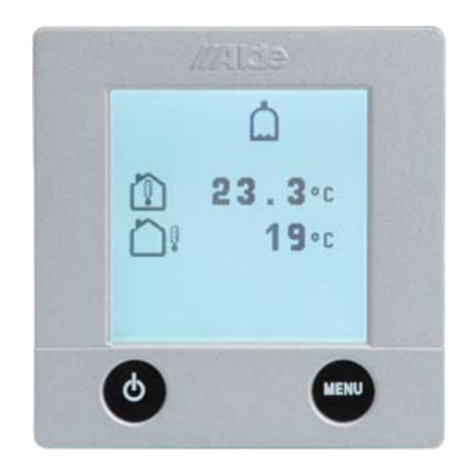
Alde
Alde 3010 413 Instructions for use and assembly

Soyal
Soyal AR-716Ei user guide
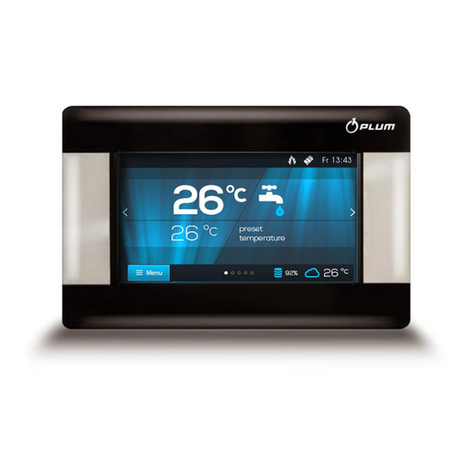
Plum
Plum ecoSTER TOUCH Operation and assembly manual
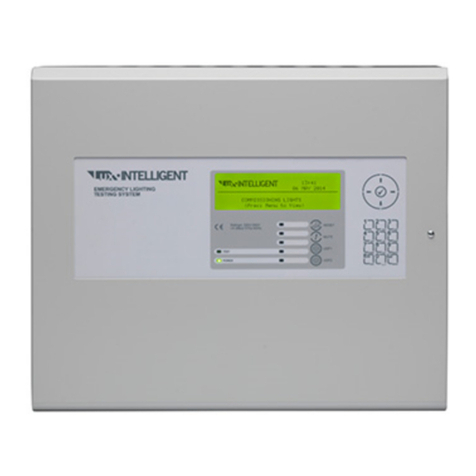
Advanced
Advanced Lux Intelligent LX-9400 product manual
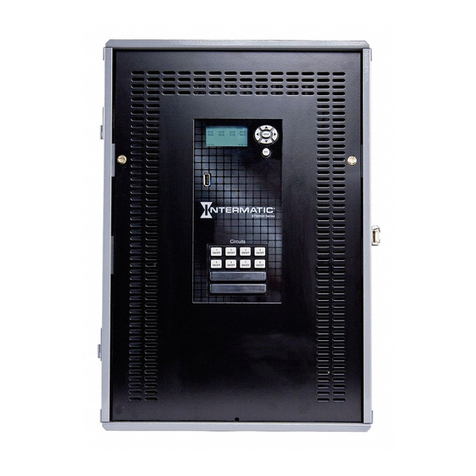
Intermatic
Intermatic ET90000 Series Installation and programming guide
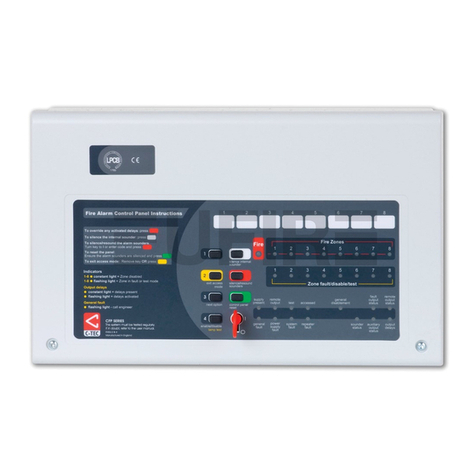
Alarm Sense
Alarm Sense CFP 8 ZONE user manual
